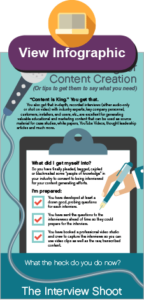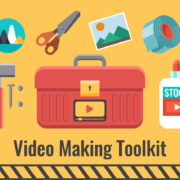Interviewing for Content Creation (Or tips to get them to say what you need)
As discussed in “The 5 Secrets of Content Driven Sales” it’s a given in that in today’s marketing world, content is king. You get that.
You also get that in-depth, recorded interviews (either audio-only or shot on video) with industry experts, key company personnel, customers, installers, end users, etc., are excellent for generating valuable educational and marketing content that can be used as source material for case studies, white papers, YouTube Videos, thought leadership articles and much more.
If you just stumbled across this article, be sure to read Creating Effective Marketing Content Efficiently for more information about the content generating process.
What did I get myself into?
So you have finally pleaded, begged, cajoled or blackmailed some “people of knowledge” in your industry to consent to being interviewed for your content generating efforts. Let’s say for the sake of this exercise you have developed at least a dozen good, probing questions for each interview, and sent the questions to the interviewees ahead of time so they could prepare for the interview. You also booked a professional video studio and crew to capture the interviews so you can use video clips as well as the raw, transcribed content. What the heck do you do now?
The Interview Shoot
Let’s assume you have sufficiently vetted the video production company via viewing samples of their work and checking references. They have their end wired. This is more about what YOU have to do to ensure a successful “content generation” shoot. Here are some tips:
Tip #1: Warm Them Up
Most people are not accustomed to being on camera and in most cases be a little or extremely nervous. The “electric eye” can melt even the most seasoned public speakers and CEOs, so it’s important that you make your interviewees feel as comfortable and at-ease as possible.
Before diving right into your content questions, warm your interviewee up with a few questions about their education, career history, current job position, responsibilities and overall business philosophy. You probably won’t use much of this stuff, but it will get the session up to speed before getting to the meat of your interview.
Tip #2: Ask Open-Ended Questions
Whether an interview is videotaped or over the phone, from your end it’s really all about the questions and how you ask them. In addition to being pertinent, probing and timely, they need to be as open ended as possible – meaning that they can’t be answered in short phrases. You want the answers to be as detailed as possible. If a question gets your subject “on a roll” and he or she talks enthusiastically for 2-3 minutes, let them go – don’t interrupt – as this scenario is exactly what you want.
Example:
Bad question: “What are the 3 main factors that are driving sales in the industry today?”
Bad answer: “Factor A, Factor B and Factor C”
Good question: “From your viewpoint, discuss how factors A, B and C are driving sales in the industry today?”
Good answer: Subject gives his opinion on A, B and C for a couple of minutes or more
Tip #3: Have Them Rephrase the Questions
A good way to get solid, complete answers to questions is to request/prompt your interviewees to re-phrase questions as the beginning of their answers.
Example:
Question: “What effect does the weather have on productivity in your division?”
Answer: “Weather effects productivity in my division in a number of ways. To begin…”
This method gives your subject good launching points for their answers. It also makes it easier on the poor sucker who has to wade through and edit all the raw video because the answers exist as complete thoughts since the question is built into the response.
Tip #4: No Question Left Behind
If a short answer could be more detailed or needs clarification, don’t give up – by all means follow up with more questions. Re-ask, or re-phrase the same question if necessary. Do a second take. Don’t be afraid to dig deep; you probably only have one shot at this. That said, not all short answers are bad. If you get a nice concise sound bite that hits all the right notes, go with it. You will know one when you see one.
Tip #5: Wardrobe Choices
Have your interview subject bring at least 2-3 different wardrobe choices. Sometimes you just don’t know what looks best until the lights and cameras are turned on and video is reviewed on a monitor. Try to stay away from white, as it can look too “hot” under lights, and greens or light blues if shooting a green screen production – where the green background is later keyed out and replaced.
Clothes with odd stripes and patterns should be used with caution, as they can look too “busy” and distracting on-screen. Be sure to “iron out” wardrobe considerations well ahead of time to avoid last minute shopping trips to the local Walmart for a pair of wrinkled khaki’s that you have to steam in the bathroom.
Wrap-Up
That’s about all for this content-driven marketing installment. If you need any assistance with prepping for content interviews or any aspect of video production, Total Spectrum is your source. We have the experience, equipment and staff to help you acquire the content you need. Contact us at 714.637.3600 and speak to one of our experts today.









